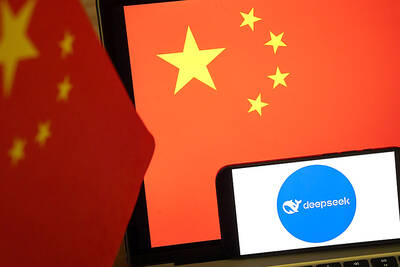The US on Wednesday laid out its most detailed case yet against Beijing’s “unlawful” claims in the South China Sea, rejecting the geographic and historic bases for its vast, divisive map.
In a 47-page research paper, the US Department of State’s Bureau of Oceans and International Environmental and Scientific Affairs said that China had no basis under international law for claims that have put Beijing on a collision course with the Philippines, Vietnam and other Southeast Asian nations.
“The overall effect of these maritime claims is that the PRC unlawfully claims sovereignty or some form of exclusive jurisdiction over most of the South China Sea,” the paper said, referring to the People’s Republic of China.

Photo: EPA-EFE
“These claims gravely undermine the rule of law in the oceans and numerous universally recognized provisions of international law reflected in the convention,” it said, referring to a 1982 UN treaty on the law of the sea ratified by China — but not the US.
Releasing the study, a state department statement called again on Beijing “to cease its unlawful and coercive activities in the South China Sea.”
China hit back yesterday, saying the report “distorts international law and misleads the public.”
“The US refuses to sign the treaty, but portrays itself as a judge and wantonly distorts the treaty,” Chinese Ministry of Foreign Affairs spokesman Wang Wenbin (汪文斌) told a briefing in Beijing.
“In seeking its own selfish interests it uses multiple standards to carry out political manipulation,” he added.
The paper is an update of a 2014 study that similarly disputed the so-called “nine-dash line” that forms the basis for much of Beijing’s stance.
In 2016, an international court sided with the Philippines in its complaints over China’s claims.
Beijing replied by offering new justifications, including saying that China had “historic rights” over the area.
The state department paper said that such historical-based claims had “no legal basis” and that China had not offered specifics.
It also took issue with geographic justifications for China’s claims, saying that more than 100 features Beijing highlights in the South China Sea are submerged by water during high tide and therefore are “beyond the lawful limits of any state’s territorial sea.”
Beijing cites such geographic features to claim four “island groups,” which the state department study said did not meet criteria for baselines under the UN convention.
The report was issued as the US increasingly challenges China on the global stage, identifying the rising communist power as its chief long-term threat.
The South China Sea is home to valuable oil and gas deposits and shipping lanes, and Beijing’s neighbors have frequently voiced concern that their giant neighbor was seeking to expand its reach.

MISINFORMATION: The generated content tends to adopt China’s official stance, such as ‘Taiwan is currently governed by the Chinese central government,’ the NSB said Five China-developed artificial intelligence (AI) language models exhibit cybersecurity risks and content biases, an inspection conducted by the National Security Bureau (NSB) showed. The five AI tools are: DeepSeek, Doubao (豆包), Yiyan (文心一言), Tongyi (通義千問) and Yuanbao (騰訊元寶), the bureau said, advising people to remain vigilant to protect personal data privacy and corporate business secrets. The NSB said it, in accordance with the National Intelligence Services Act (國家情報工作法), has reviewed international cybersecurity reports and intelligence, and coordinated with the Ministry of Justice Investigation Bureau and the National Police Agency’s Criminal Investigation Bureau to conduct an inspection of China-made AI language

LIMITS: While China increases military pressure on Taiwan and expands its use of cognitive warfare, it is unwilling to target tech supply chains, the report said US and Taiwan military officials have warned that the Chinese People’s Liberation Army (PLA) could implement a blockade within “a matter of hours” and need only “minimal conversion time” prior to an attack on Taiwan, a report released on Tuesday by the US Senate’s China Economic and Security Review Commission said. “While there is no indication that China is planning an imminent attack, the United States and its allies and partners can no longer assume that a Taiwan contingency is a distant possibility for which they would have ample time to prepare,” it said. The commission made the comments in its annual

‘TROUBLEMAKER’: Most countries believe that it is China — rather than Taiwan — that is undermining regional peace and stability with its coercive tactics, the president said China should restrain itself and refrain from being a troublemaker that sabotages peace and stability in the Indo-Pacific region, President William Lai (賴清德) said yesterday. Lai made the remarks after China Coast Guard vessels sailed into disputed waters off the Senkaku Islands — known as the Diaoyutai Islands (釣魚台) in Taiwan — following a remark Japanese Prime Minister Sanae Takaichi made regarding Taiwan. Takaichi during a parliamentary session on Nov. 7 said that a “Taiwan contingency” involving a Chinese naval blockade could qualify as a “survival-threatening situation” for Japan, and trigger Tokyo’s deployment of its military for defense. Asked about the escalating tensions

DISPUTE: A Chinese official prompted a formal protest from Tokyo by saying that ‘the dirty head that sticks itself out must be cut off,’ after Takaichi’s Taiwan remarks Four armed China Coast Guard vessels yesterday morning sailed through disputed waters controlled by Japan, amid a diplomatic spat following Japanese Prime Minister Sanae Takaichi’s comments on Taiwan. The four ships sailed around the Senkaku Islands — known as the Diaoyutai Islands (釣魚台) to Taiwan, and which Taiwan and China also claim — on Saturday before entering Japanese waters yesterday and left, the Japan Coast Guard said. The China Coast Guard said in a statement that it carried out a “rights enforcement patrol” through the waters and that it was a lawful operation. As of the end of last month,